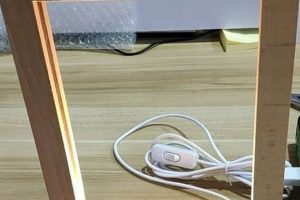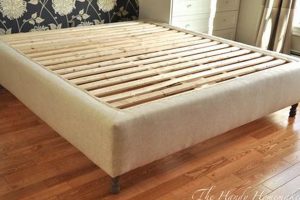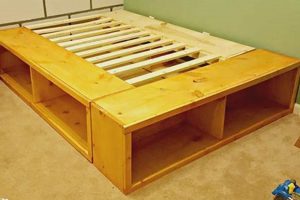A self-constructed sleeping platform designed to accommodate a standard queen-size mattress (60 inches wide by 80 inches long) represents a significant undertaking in home furnishing. This project requires planning, material selection, and execution of construction techniques to create a structurally sound and aesthetically pleasing support for bedding. For example, lumber, fasteners, and finishing products are typically employed to realize the final structure.
Constructing a bed foundation offers several advantages, including cost savings compared to purchasing pre-made furniture. Customization is another key benefit, allowing for personalization of dimensions, materials, and style to match individual preferences and room decor. Historically, crafting one’s own furniture reflected resourcefulness and skill, a tradition that continues to appeal to individuals seeking unique and personalized home environments.
The subsequent discussion will delve into essential considerations for such a project, including design planning, material selection criteria, the necessary tools and equipment, and step-by-step construction guidelines. Furthermore, finishing techniques and safety precautions will be addressed to ensure a successful and durable outcome.
Essential Considerations for Self-Constructed Queen Bed Foundations
The following guidelines offer crucial advice for achieving a durable and aesthetically pleasing outcome when undertaking this substantial woodworking endeavor.
Tip 1: Precise Dimensional Planning: Accurate measurement of the intended mattress is paramount. Account for potential discrepancies in stated versus actual mattress dimensions to avoid fitment issues. Add a small tolerance (e.g., 1/4 inch) to the internal frame dimensions to facilitate easy mattress insertion and removal.
Tip 2: Structural Integrity Foremost: Prioritize robust joinery techniques, such as mortise and tenon, dovetails, or reinforced screw connections with wood glue. The bed foundation must reliably support the weight of the mattress and occupants without sagging or instability. Evaluate weight-bearing capacity based on anticipated usage.
Tip 3: Material Selection Based on Durability: Opt for hardwoods like oak, maple, or birch for key structural components. Softwoods, such as pine, can be used for less critical elements, but ensure adequate thickness and support. Consider the material’s resistance to warping and insect infestation.
Tip 4: Comprehensive Cutting List: Develop a detailed cutting list before commencing any physical work. This minimizes material waste and helps ensure all components are prepared to the correct dimensions. Double-check all measurements for accuracy before cutting any lumber.
Tip 5: Leveling and Squaring are Critical: Throughout the construction process, consistently verify that all components are level and square. Imperfections in alignment will compromise the bed’s stability and aesthetics. Use a level, square, and measuring tape frequently.
Tip 6: Surface Preparation and Finishing: Thoroughly sand all surfaces before applying any finish. A smooth surface enhances the appearance and prevents splinters. Select a durable finish appropriate for bedroom furniture, such as polyurethane or varnish, ensuring it is low-VOC for improved air quality.
Tip 7: Hardware Selection Matters: Choose high-quality fasteners that are appropriate for the materials being joined. Avoid using undersized screws or nails, which can weaken the structure. Consider using bed frame brackets for easy assembly and disassembly.
Tip 8: Safety First: Always wear appropriate personal protective equipment, including safety glasses, dust mask, and hearing protection, when using power tools. Ensure the work area is well-ventilated, and follow all safety guidelines for each tool used.
Adherence to these suggestions fosters the creation of a sturdy, lasting, and visually appealing piece of bedroom furniture, enhancing both comfort and the overall aesthetic of the sleeping space.
The ensuing section will explore common design variations and aesthetic embellishments for such a construction project.
1. Accurate dimensions
Accurate dimensions are foundational to the successful execution of a self-constructed queen-size bed support structure. Deviations from specified measurements during the design and cutting phases directly impact the structural integrity and aesthetic appeal of the completed project. For example, a bed foundation built with inaccurate internal dimensions may either fail to adequately support the mattress, leading to premature wear, or create an unsightly and uncomfortable sleeping surface. Conversely, external dimensional errors could result in the structure not fitting appropriately within the intended bedroom space.
The relationship between precise measurements and a functional bed extends beyond mere aesthetics. A miscalculation in the height of the side rails could create an uneven sleeping surface, leading to discomfort. Inaccurate leg measurements could compromise the overall stability of the bed, potentially resulting in structural failure over time. Therefore, meticulous attention to detail during the planning and cutting stages, coupled with the use of precise measuring tools, is paramount. A common practical application involves creating a detailed cutting list, ensuring all lumber components are accurately sized before assembly.
In summary, the impact of accurate dimensions on a DIY queen bed frame cannot be overstated. Imprecise measurements directly compromise structural integrity, aesthetics, and overall functionality. While challenging, meticulous planning, careful execution, and vigilant verification of all dimensions are essential for achieving a satisfactory and long-lasting result. Overcoming these challenges yields a sleeping platform that not only meets dimensional requirements but also enhances the comfort and aesthetic value of the bedroom.
2. Structural Integrity
The structural integrity of a self-constructed queen-size bed foundation directly determines its longevity, safety, and functionality. Compromises in structural soundness can lead to premature failure, creating potential safety hazards and negating the economic benefits of a do-it-yourself project. A bed foundation lacking sufficient strength may exhibit sagging, instability, or complete collapse under the combined weight of the mattress and occupants. Such failures often stem from inadequate joinery, undersized lumber, or improper weight distribution considerations during the design phase. For instance, a common error involves using insufficient support for the center of the bed frame, resulting in bowing over time. This highlights the cause-and-effect relationship between design decisions and structural performance.
Employing robust construction techniques and selecting appropriate materials are crucial for achieving adequate structural integrity. Techniques such as mortise and tenon joints, dovetail joints, or reinforced screw connections with wood glue significantly enhance the load-bearing capacity of the frame. Similarly, choosing hardwoods, like oak or maple, for key structural components provides greater resistance to bending and deformation compared to softer woods like pine. Practical applications of this understanding involve conducting thorough stress calculations, considering anticipated weight loads, and employing appropriate safety factors in the design. Further, reinforcing critical areas, such as the corners and center supports, ensures a more robust and durable structure. A real-life example would be observing how professionally manufactured bed frames utilize metal reinforcement brackets in high-stress areas.
In conclusion, the structural integrity of a self-made queen bed frame is not merely a desirable attribute, but a fundamental requirement for a safe, functional, and long-lasting piece of furniture. Ignoring this aspect can lead to potentially hazardous failures, undermining the entire purpose of the project. Addressing this concern through careful design, selection of appropriate materials, and employing robust construction techniques will yield a sleeping platform that can reliably support its intended load for years to come. The challenge lies in balancing cost-effectiveness with the need for robust structural performance, demanding careful planning and execution.
3. Material Selection
Material selection is a critical determinant of the durability, aesthetic appeal, and overall cost of a self-constructed queen-size bed foundation. The choice of materials directly impacts the structural integrity, weight-bearing capacity, and resistance to wear and tear of the final product. Inappropriate material choices can lead to premature failure, rendering the project unsustainable. For example, utilizing softwood lumber for key structural components, such as side rails or leg supports, can result in sagging or breakage under the combined weight of a mattress and occupants. Conversely, selecting high-quality hardwoods may significantly increase the upfront cost but ensures greater longevity and stability, representing a more sustainable investment in the long term. Therefore, a thorough evaluation of material properties and cost considerations is essential.
The connection between material selection and the design of a bed structure extends beyond structural considerations to encompass aesthetic preferences and finishing options. Different wood species offer distinct grain patterns, colors, and textures, influencing the overall visual character of the bed frame. For example, oak exhibits a prominent grain pattern that complements traditional design styles, while maple offers a smoother, more uniform appearance suitable for contemporary aesthetics. Additionally, the choice of material influences the type of finish that can be effectively applied. Certain finishes, such as stains, may accentuate the natural grain of the wood, while others, such as paint, provide a more uniform color coverage. The practical significance of this understanding is evident in the careful consideration given to matching the bed frame’s material and finish to existing bedroom furniture and dcor.
In summary, material selection is an indispensable element in a DIY queen-size bed project, fundamentally shaping its structural integrity, aesthetic appeal, and long-term value. While cost is a significant factor, prioritizing durability and resistance to wear is crucial for ensuring the project’s success. Carefully evaluating the properties of different materials and their compatibility with desired finishes will lead to a more functional, visually pleasing, and sustainable outcome. The primary challenge lies in balancing cost-effectiveness with the need for high-quality materials that meet both structural and aesthetic requirements, demanding a thorough understanding of wood properties and construction techniques.
4. Joinery Techniques
The selection and execution of appropriate joinery techniques are paramount to the structural integrity and longevity of any self-constructed queen-size bed foundation. These techniques dictate how individual lumber components are connected, directly influencing the bed frame’s ability to withstand stress, resist racking, and maintain its form over time. Inadequate joinery will result in a structurally unsound bed, prone to instability and premature failure.
- Mortise and Tenon Joints
This traditional joint involves fitting a projecting tenon from one piece of wood into a precisely cut mortise in another. The mortise and tenon joint, when properly executed and secured with adhesive, provides exceptional strength and resistance to racking forces. Historically, this has been a staple in furniture construction. Examples in bed frames include connecting side rails to headboards and footboards.
- Dovetail Joints
Characterized by interlocking, wedge-shaped projections (dovetails) that fit snugly into corresponding recesses, dovetail joints offer superior tensile strength and resistance to pull-apart forces. While more complex to execute, dovetails are commonly employed in drawer construction within a bed frame or for decorative corner joinery. The visual appeal and mechanical strength make it a premium choice.
- Lap Joints
Lap joints are created by overlapping two pieces of wood and securing them with fasteners and adhesive. This simpler technique is suitable for less critical structural connections, such as attaching bed slats to the side rails or creating frame components. While easier to execute than mortise and tenon or dovetail joints, lap joints offer reduced strength and resistance to racking. The success of these joints relies heavily on the adhesive and fasteners used.
- Pocket Hole Joinery
Pocket hole joinery involves drilling angled holes into one workpiece and then driving screws through these holes into an adjacent piece. This method allows for concealed screw connections, resulting in a clean and visually appealing appearance. While relatively quick and easy to implement, pocket hole joinery may not provide the same level of structural strength as traditional joinery techniques. It’s often used for attaching face frames or constructing less-stressed components of the bed frame.
The choice of joinery techniques directly influences the overall quality and durability of a do-it-yourself queen-size bed foundation. While simpler methods like lap joints and pocket hole joinery offer ease of construction, they may compromise the bed’s long-term structural integrity. Traditional techniques like mortise and tenon or dovetail joints provide superior strength and resistance to racking, but require greater skill and precision. Therefore, selecting the appropriate joinery techniques based on the intended use, skill level, and available tools is essential for achieving a successful and lasting result.
5. Finishing applications
Finishing applications constitute a crucial phase in the creation of a self-constructed queen-size bed foundation, significantly impacting the aesthetic appeal, durability, and protection of the wood surface. Selection of the appropriate finishing method directly influences the lifespan and maintenance requirements of the completed structure.
- Surface Preparation
Prior to any finishing application, meticulous surface preparation is essential. This involves sanding to create a smooth, uniform surface free from imperfections. Proper sanding ensures the finish adheres effectively and achieves the desired appearance. Failure to adequately prepare the surface will result in an uneven finish, highlighting scratches or imperfections in the wood. Examples include using progressively finer sandpaper grits (e.g., 120, 180, 220) and thoroughly removing sanding dust before proceeding.
- Staining
Staining is a finishing technique used to enhance the natural grain and color of the wood. It penetrates the wood fibers, altering their appearance without obscuring the underlying grain pattern. Staining allows for customization of the bed frame’s aesthetic, enabling it to complement existing bedroom furniture. Real-world examples include applying different stain colors (e.g., cherry, walnut, mahogany) to achieve a desired hue and matching the stain to existing decor. Incorrect staining application can lead to blotchiness or uneven color distribution.
- Sealing
Sealing involves applying a clear coating to protect the wood from moisture, dirt, and scratches. A sealant creates a barrier that prevents the wood from absorbing liquids, reducing the likelihood of warping or staining. Sealants also provide a smooth surface for subsequent finishing layers. Common sealants include polyurethane, varnish, and shellac. In the context of a bed frame, a durable sealant is particularly important to protect against spills and wear and tear. Practical implications involve selecting a sealant appropriate for the intended use and application environment (e.g., low-VOC sealant for improved indoor air quality).
- Top Coating
The top coating provides the final layer of protection and enhances the aesthetic appeal of the finished bed frame. Top coats offer varying levels of durability, gloss, and resistance to scratches and chemicals. Polyurethane, lacquer, and varnish are common top coat options. Examples of top coating considerations include selecting a high-gloss finish for a modern look or a matte finish for a more rustic aesthetic. Durability is key in bed frame construction. Proper application of the top coat ensures the bed frame maintains its appearance and structural integrity over time.
The success of a self-constructed queen-size bed frame hinges not only on sound structural design and construction techniques but also on the judicious selection and execution of finishing applications. The discussed facets, spanning from surface preparation to top coating, collectively contribute to the aesthetic quality, protective properties, and long-term durability of the completed project. Neglecting any of these facets can significantly compromise the overall outcome, diminishing the value and longevity of the bed frame. This integrated approach is pivotal for achieving a professional and lasting result.
Frequently Asked Questions
The following section addresses common inquiries regarding the construction of a self-made queen-size bed foundation. These responses aim to provide clear, factual information to aid in informed decision-making and project execution.
Question 1: What is the minimum recommended lumber thickness for a queen-size bed frame to ensure adequate support?
For main structural components like side rails and legs, a minimum thickness of 1.5 inches (actual dimension) is generally recommended when using hardwoods such as oak or maple. Softwoods, such as pine, may require greater thicknesses to achieve comparable structural support.
Question 2: What are the essential tools required for constructing a bed foundation?
Essential tools include a measuring tape, a combination square, a circular saw or table saw for cutting lumber, a drill/driver for fastening, a level, sandpaper, and appropriate safety equipment (safety glasses, dust mask, hearing protection).
Question 3: What are the most common mistakes to avoid during bed frame construction?
Common mistakes include inaccurate measurements, inadequate joinery, insufficient support for the center of the frame, improper surface preparation before finishing, and neglecting safety precautions.
Question 4: What type of finish is most durable and suitable for a bed frame in a residential bedroom?
Polyurethane and varnish finishes are generally considered durable and appropriate for bed frames due to their resistance to scratches, moisture, and chemicals. Low-VOC formulations are recommended to minimize indoor air pollution.
Question 5: How can racking be prevented in a bed frame structure?
Racking, or the tendency of a frame to deform laterally, can be prevented by employing robust joinery techniques (e.g., mortise and tenon joints), adding corner bracing, and ensuring all connections are securely fastened.
Question 6: Is it possible to build a bed frame without advanced woodworking skills?
Yes, simpler designs utilizing basic joinery techniques like lap joints or pocket hole joinery can be achieved by individuals with limited woodworking experience. However, more complex designs and traditional joinery methods require a higher level of skill and precision.
This section provides a concise overview of vital aspects. Careful planning, attention to detail, and adherence to safety guidelines will significantly increase the likelihood of a successful outcome.
The succeeding portion will cover design variations and aesthetic considerations for the self-constructed bed structure.
Conclusion
The preceding exploration of the self-assembled queen-size bed support has illuminated critical considerations ranging from precise dimensional planning and material selection to robust joinery techniques and appropriate finishing applications. Adherence to these principles directly impacts the structural integrity, longevity, and aesthetic appeal of the final product. A meticulously constructed frame ensures a stable and enduring sleeping platform.
Ultimately, the decision to undertake the construction of a bed foundation represents a significant investment of time and resources. A thorough understanding of the discussed elements is crucial for a successful and rewarding outcome. The acquisition of this knowledge facilitates the creation of a sleeping platform that not only meets functional requirements but also embodies individual craftsmanship and design preferences, thereby enhancing the value and personalization of the home environment.







